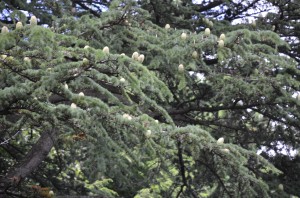Cedar of Lebanon (Cedrus libani) is a tree aristocrat among conifers. Among the true evergreen cedars it is rated the cold hardiest (USDA zone 5). Its broad horizontal branching and dark green needles defines this tree. The bright green tufted needles are less than 1 inch long and not as showy as the more popular Atlas cedar (C. atlantica) from Morocco.
In its first 25-40 years, cedar of Lebanon takes on a predominantly vertical form. As the tree ages, branching widens and develops its distinctive, flat-topped canopy. Its tufts of 30 to 40 short evergreen needles are borne on short spurs. The 4-inch barrel-shaped cones lie upright on the branches. The cones take two years to mature and disperse seed in late autumn.
Cedar of Lebanon grows slowly, less than one foot per year. The long-lived cedar becomes grander with age. At full maturity, it may reach 60-70 feet in height and spread. Starting out, give it lots of room and a full day of sunlight. The soil should be moist, loamy and well-drained. A large specimen tree demonstrates good heat and drought tolerance, but is susceptible to urban air pollutants.
Cedar of Lebanon is the tree that seems a part of recorded human history from the Phoenician, Egyptian and Roman Empires. Traveling through England, you can’t miss seeing hundreds of lovely tall specimens planted almost 200 years ago, commemorating Napoleon’s defeat at Waterloo in 1815. Efforts are in progress to reforest trees in the geographic area between Lebanon and Turkey where it is indigenous.
Cedar of Lebanon is best planted on park grounds, golf courses, and other large properties. A few dwarf forms are available for purchase from on-line specialty conifer nurseries.


 Posted in
Posted in 
